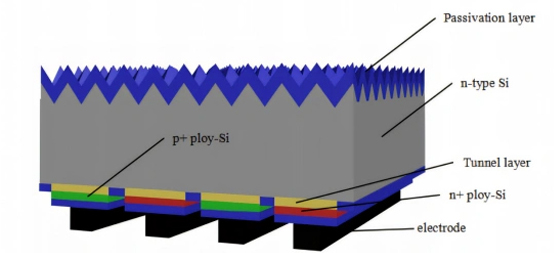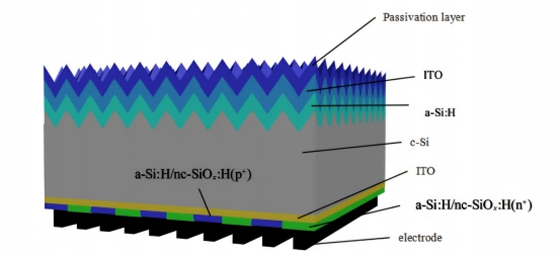Solar energy is attracting attention as the energy source of the future in the next generation of products.HPBC is one of the directions in the development of solar cell technology.HPBC cells have the advantage of a back-contact design in conjunction with passivated emitter and back-side passivated contact technology (PERC). This structure typically creates a passivated contact on the backside of the cell to reduce frontal shielding and improve light absorption.

HPBC cell, full name Hybrid Passivated Back Contact (HPBC), is a new generation of high-efficiency solar cell technology.
Structural features: HPBC cells with passivated emitter and back surface passivated contact combined (PERC) using back contact design, the structure usually formed on the back of the battery passivation contact to reduce frontal shading, improve light absorption. Passivation effect:The passivation layer of HPBC cells helps to reduce surface compounding and increase the open-circuit voltage (Voc) of the cell.
Technical features:HPBC cell technology combines TOPCon and IBC technology to move all the cell metal grid lines, which are responsible for collecting and transporting carriers, to the back side of the module, making the front side of the cell free of grid line blockage, thus improving light utilization and photovoltaic conversion efficiency.
Technical Advantage: HPBC batteries are characterized by strong light absorption, high conversion efficiency, stable power transmission, beautiful products, and mature and reliable technology.
Application Scenario: HPBC cells are naturally suitable for distributed PV scenarios, especially BIPV (Building Integrated Photovoltaic), which can fully combine the aesthetics of BC modules and architectural art.

TBC(TOPCon Back Contact) TBC battery, full name is TOPCon and IBC technology combined battery, also known as POLO-IBC battery. Structural features: TBC battery adopts tunnel oxide layer passivation contact (TOPCon) and applies it to the back contact structure. The design utilizes the high passivation quality and good contact characteristics of TOPCon technology.
Efficiency potential: TBC cells have a high efficiency potential due to their excellent passivation properties and back contact design. Industrialization process: Currently, the TBC battery technology route is in the laboratory research stage, and there are still many issues that need to be resolved in order to advance the industrialization process. In the short term, the TBC battery route has a broader development prospect, because the TOPCon process route is more mature than the HJT process route, the cost is lower, and the TBC production line is partially compatible with the TOPCon production line.
Application Potential:TBC cells can be applied not only to N-type crystalline silicon substrate, but also to P-type substrate, which has great potential to improve the photoelectric conversion efficiency and reduce costs.

HBC (Heterojunction Back Contact) solar cells HBC cells, that is, heterojunction back contact crystalline silicon cells, is a combination of heterojunction (HJT) back contact technology and cross index (IBC) high-efficiency solar cell technology.
Structural features: HBC cells utilize heterojunction technology in combination with a back-contact structure. In order to achieve efficient carrier collection, this structure usually forms a heterojunction on the backside of the cell.
High Efficiency Potential: HBC cells are considered to be a strong candidate for high efficiency solar cells due to their excellent heterojunction characteristics and back-contact design. hpbc, tbc, and hbc cells all represent advances in photovoltaic cell technology, with different technological paths to increase the photovoltaic conversion efficiencies of the cells. In terms of conversion efficiency, TBC and HBC cells outperform the classic IBC technology. HBC cells combine the surface passivation properties of HJT cells with the advantages of metal-free shielding on the front side of IBC cells, and have the dual advantages of high short-circuit currents and high open-circuit voltages, and represent the highest photovoltaic conversion efficiencies for crystalline silicon solar cells.







